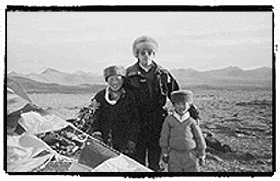
Journey to Tibet
Written by Adam Graham | Posted by: Anonymous
Produced in Vermont by husband-and-wife team Alan Dater and Lisa Merton, the film Home to Tibet portrays an exiled Tibetan who makes an emotional, spiritual and often times dangerous sojourn to his homeland in rural Tibet. Sonam, now a mason worker in Brimfield, Massachusetts was exiled from Tibet 17 years ago as a result of the Chinese occupation. After a grueling 14-day escape where he lived off the roadside in fear of being caught by Chinese authorities, he departed his homeland, leaving behind a sister who raised him, and an extended family still hopeful of Tibet’s independence and Sonam’s long-awaited return.
Along his journey back home, Sonam encounters the Dalai Lama in India, describes what a credit card is to a Buddhist monk, raises prayer flags in Nepal, and crosses the Freedom Bridge from Nepal to Tibet, the very bridge he escaped over 17 years ago. This is an emotional documentary, refreshing in its presentation of the truth, and educational in it’s treatment of modern history. Home to Tibet will be shown at The Vermont International Film Festival on Saturday, October 25th.
Adam: First of all I’d like to say what a beautiful documentary I thought Home to Tibet was. I think that a lot of documentary filmmakers fall into the trap of trying too hard to be objective, and consequently end up with a finished piece that can feel sterile or lack the kind of emotional charge that really makes your film so great.
Lisa and Alan: Thanks.
Adam: My first question is, How on earth did you get that great Chinese propaganda and security camera footage?
Lisa: Well it’s actually footage that you’ll see in many other films about Tibet. The story is that a British Journalist approached a Chinese guard in Tibet, who had just removed a tape from one of the street surveillance cameras, and the journalist said to the guard, "Can I please have that tape…it would be a great thing to have to show the rest of the world to prove what rambunctious, disorderly, and disrespectful people the Tibetans are…I think it would really help your cause," and so the guard unknowingly gave him the tape.
Adam: The footage is startling and I think it is used as a good illustrative tool in your film, which deals very personally with the account of the Chinese Occupation in Tibet.
Lisa: Yes it is startling, and probably not so different from brutal police footage from any country in the world, but it still certainly makes a very strong statement.

Adam: There are scenes later in the film where Sonam is in a room with the Dalai Lama, and asking him for spiritual advice. Filming the Dalai Lama in such an intimate setting as you did would seem to be quite a daunting task. Did you run into any complications with the issues of an entire film crew in these very intimate settings?
Alan: No. In fact, you should know that I was the entire film crew, so there wasn’t as much disturbance as you would think. And I don’t think that the Dalai Lama minded being filmed at all. In fact, I shot an entire hour of an interview with just him afterwards, and he was fine with it.
Adam: So you never felt oppressive being the person capturing Sonam’s emotional life story on tape? Was the camera ever changing the dynamics of what was happening?
Alan: I don’t think that I affected the situation all that much. I think that documentary filmmaking is not so much like being a fly on the wall, but rather like a dance where you’re moving along with your subject, and sort of dancing with them one step at a time. It is a very intimate situation, but as a filmmaker, it helps to know a little something about human nature and perhaps about the person you are shooting too.
Adam: There also seems to be a strand of Buddhism that runs throughout this film. The Dalai Lama’s seemingly irrelevant advice to Sonam is to educate Tibet’s children while visiting his village. Strangely enough, the children of this film become an integral part of Sonam’s mission as well as an integral part of the film’s emotional spark. It didn’t strike me until the end of the film that the way it all unfolded was quite Buddhist in itself. Was this what you had intended as filmmakers, and are you both Buddhists yourselves?
Lisa: No, I don’t think that we had any particular intentions like that when we began this project, and we certainly didn’t plan to have the film unfold in any particular way. And I don’t really think that either of us are Buddhists, even though we may live in such a way. We do believe in sustainability and respect for all things, and that we all impact the environment around us… I guess it’s a Buddhism without the beliefs.
Adam: So what was your main objective in making this film?
Alan: In the beginning, there wasn’t really a main objective. We just saw it as a great opportunity to make a film about Tibetans. Sonam mentioned that he was interested in returning home to visit Tibet, and I asked him if I could come along with him and make a documentary about it. And he said yes. It just so happened that we met up with the Dalai Lama, none of it was really planned. I guess it was just fate that we did.
Lisa: Serendipity.
Adam: So how long did you know Sonam before?
Alan: We met in October of 1993, and so I knew him for quite a while before we began shooting the following winter. We also decided that it might be helpful having an American with him while going through the Tibetan border.
Adam: Was it?
Alan: Actually no, we didn’t have any trouble getting through.
Lisa: Well, also Sonam had a lot of prayers said for him.
Alan: Yes, one thing about Sonam is that he is very conscientious about having prayers said by lots of different people for him. It was a very important part of the process for him during this whole trip. And so everywhere we went, there were prayers said for Sonam.
Adam: Well I think one of the most beautiful scenes of the film was when the prayer flags were raised for Sonam in Nepal. Is that a Tibetan Tradition?
Alan: Yes that’s an old Tibetan Buddhist tradition, spreading prayers into the wind.
Lisa: There are many Tibetans in Nepal.
 Adam: The long anticipated reunion when Sonam finally meets his sister in Tibet happens so fast that I wasn’t sure if it was actually her at first…
Adam: The long anticipated reunion when Sonam finally meets his sister in Tibet happens so fast that I wasn’t sure if it was actually her at first…
Lisa: He wasn’t either…
Adam: Sonam’s reaction was surprising, and almost chilly, as if he didn’t want to let himself feel anything. What do you think caused him to react like that?
Lisa: I think that you put your finger right on it, I think that he couldn’t help but feel emotional, but I don’t think that he wanted to show it. He didn’t want the situation to fall apart, and if you think about the differences from west to east, from secular to religious, from a long time in the past to suddenly seeing somebody he hadn’t seen in years, such vast changes had occurred with everything sort of culminating right in that instant of seeing her. It was shocking initially and we thought "Gosh… how are people going to react to this. This isn’t what anybody suspected would happen." But there’s something so honest about his reaction, whether it seems anti-climactic or not, that’s just what happened.
Adam: I wonder how many directors would try to contrive a situation like that, and force someone to be emotional. As a western viewer, it did take me a while to realize that this was Sonam’s honest reaction, and my appreciation for this scene was latent until I eventually realized that there might be some cultural differences at work here.
Alan: It does give you some insight to the changes that Sonam was going through while out of his old culture… I think that by understanding a bit of their [Tibetan] culture we can understand Sonam’s reaction a little more. They don’t necessarily allow their emotions to tie them together, like we do. It’s just a different way of thinking.
Adam: So you do think that it is a cultural difference, rather than the fact that there was a camera on him and that he was being completely scrutinized by the crowd at that particular point.
Lisa: Well, that too. If you think of all the elements that came together in that split second, you realize how perplexing it must have been for him. And I do think that there’s plenty of warmth, too. You notice that as the film goes along that he becomes much more comfortable with his sister, and when he leaves he hugs her twice. I think it was just a manifestation of shock. Because it’s not what we want in the western world, we want a big embrace with tears, and shouts of joy. It’s not what we, as the filmmakers expected either.
Adam: Sonam seems to be a ray of hope for his family, and a ray of hope for the persistence of Tibetan culture. How do you think his visit to Tibet has changed his life. And how has the film changed his life?
Lisa: Well, I think the visit changed his life because he reconnected with his teachers, who have both been here since the film was made, which is incredible – that both of his teachers have been here. Sonam’s niece from the film is also coming over to go to school for a year here. She will be here for the film festival and we’ll try to bring her to Burlington to see it. I think because we’ve done screening around New England and on the west coast, and Sonam has always been with us, it’s given people a chance who don’t know anything about Tibet to really learn something about it in a personal fashion, and to meet Sonam, and it’s been wonderful for him to meet so many people interested in his culture. And he continues to teach people what is important about Tibet and its traditions.
Adam: What was the budget for this film?
Lisa: $80,000 and we raised half the money ourselves, paid for it out of our own pocketbooks. It was a real labor of love, right Alan?
Alan: Right, there wasn’t actually time to do much fundraising before the shooting of the film, and so it wasn’t until after we got back from Tibet that we did a great deal and that was when the rest of it was raised.
Adam: So you haven’t received any kind of profit from this yet?
Lisa: No we haven’t seen any money from it for a year and a half now.
Adam: Well, I hope that it pays itself off in other ways.
Lisa: Oh it has immeasurably.
Email the author at Ahgraham@aol.com.
Photos courtesy of the Vermont International Film Festival, Alan Dater and Lisa Merton.
For more information regarding Marlboro Productions or Lisa and Allen’s future projects, please contact them at MFilmpro@sover.net. Email the author at Ahgraham@aol.com. Photos courtesy of the Vermont International Film Festival, Alan Dater and Lisa Merton.










